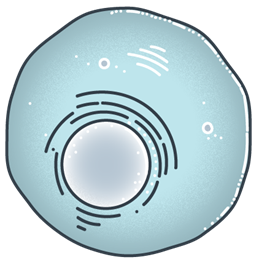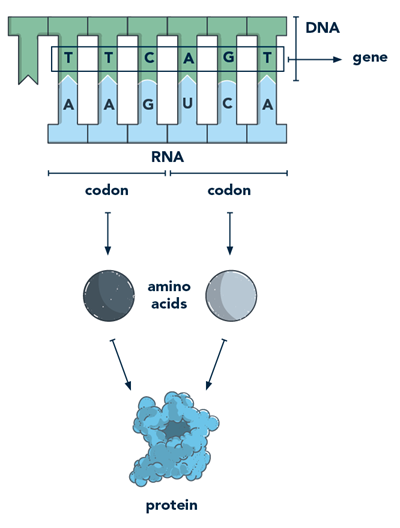The basics of our body

Cells
See glossary for more terms >. The human body has trillions of cells divided into different types: There are muscle cells, bone cells, kidney cells, red blood cells,Red blood cellsthe blood cells that carry oxygen
See glossary for more terms > and white blood cellsWhite blood cellscells the body makes to help fight infections
See glossary for more terms >. All of these cells work together to keep us alive. Some carry out functions like converting food to energy. Other cells provide structural support, giving our organs and our body shape and strength.1

Chromosomes
See glossary for more terms >—the control center of each cell. Within the nucleus, you’ll find structures called chromosomesChromosomesan organized structure of DNA found in the nucleus of the cell. Humans have 23 pairs of chromosomes, and they receive half from their mother and half from their father
See glossary for more terms >. Our chromosomes are made up of proteins and DNA (deoxyribonucleic acid)DNA (deoxyribonucleic acid)the hereditary material in humans and almost all other organisms
See glossary for more terms >.1 Except for sperm and egg cells, every cell in a human body normally has 23 pairs of chromosomes (for a total of 46). You inherit one set of 23 chromosomes from your mother and the other 23 from your father.2


DNA
- Adenine (usually referred to as just “A”)
- Cytosine (or “C”)
- Guanine (or “G”)
- Thymine (or “T”)
See glossary for more terms >. The order (or sequence) of these base pairs carries your genetic informationGenetic informationthe hereditary information coded in a person’s DNA or RNA
See glossary for more terms >. This sequence of base pairs helps to determine your physical characteristics, such as your skin color and your height.2
See glossary for more terms >, which is another way to describe your genetic material or your DNA. Within your genome, your DNA is organized into sections of information called genesGenesinstructions made of DNA used to create the proteins the body needs to function
See glossary for more terms >. Each gene is made up of a unique sequence of the building blocks we talked about above (A, C, G, T). Genes are important because they provide instructions that tell each cell how to make proteins.2
See glossary for more terms >, which is another way to describe your genetic material or your DNA. Within your genome, your DNA is organized into sections of information called genesGenesinstructions made of DNA used to create the proteins the body needs to function
See glossary for more terms >. Each gene is made up of a unique sequence of the building blocks we talked about above (A, C, G, T). Genes are important because they provide instructions that tell each cell how to make proteins.2

Proteins

 Gene-ius Questions
Gene-ius Questions
At the smallest level, a large amount of base pairs (chemical building blocks A, C, G, T) make up DNA. Sections of DNA then make up genes. Multiple strands of DNA wind around themselves and other structural proteins to create chromosomes. And last, chromosomes are located inside the nucleus of a cell.2
Defining DNA: coding and non-coding
The genome (all the DNA in the body) includes regions that are coding and non-coding.1
Coding DNACoding DNAregions within a gene that provide the instructions to produce a protein
See glossary for more terms > refers to regions within a gene that provide the instructions to produce a protein. There are an estimated 20,000 genes that code for proteins in the human genome, making up about 1% of the genome.1,4
Non-coding DNANon-coding DNADNA sequences that do not code for amino acids; some non-coding DNA has no known function, while other non-coding DNA plays a role in regulating gene expression
See glossary for more terms > makes up approximately 99% of the human genome. Non-coding DNA does not provide instructions to produce proteins but may serve other functions, such as1:
- Giving a cell the instructions to regulate when and where a gene is turned on and off1
- Telling a cell how to produce different types of ribonucleic acid (RNA)Ribonucleic acid (RNA)a nucleic acid that is present in all human cells. It is the product of transcription and acts as an intermediary between DNA and proteins
See glossary for more terms >, another nucleic acid closely related to DNA that is involved in making proteins (protein synthesis)1 - Showing where the beginning and end of a gene is1
- Providing structural elements to chromosomes, such as telomeresTelomeresrepetitive sequence of noncoding DNA at the end of a chromosome, which protects the chromosome from damage during cell division
See glossary for more terms >, which protect the ends of chromosomes from degrading when the DNA is replicating1
 Gene-ius Questions
Gene-ius Questions
 Genetic codes are instructions that your DNA gives to your cells to make specific proteins. If you recall, a genetic code is made up of the letters A, C, G, and T. Three-letter combinations of these letters (eg, GCA) provide the code for amino acidsAmino acidsa set of 20 different molecules used to build proteins
Genetic codes are instructions that your DNA gives to your cells to make specific proteins. If you recall, a genetic code is made up of the letters A, C, G, and T. Three-letter combinations of these letters (eg, GCA) provide the code for amino acidsAmino acidsa set of 20 different molecules used to build proteinsSee glossary for more terms > that are needed to make proteins. These proteins then go on to perform the essential functions of the cell.1

Where do our genes come from?
Genes are passed down from our parents, which is why key traits tend to remain the same across family members.1
Every person has 2 copies of each gene; 1 of each of the 23 chromosomes you inherit from each parent. And 99.9% of the genes in the human genome are identical from person to person.1 The rest are variants, meaning they can vary a small amount from person to person. These variants are called alleles. Alleles account for many of the differences we have from person to person, such as physical traits like eye color, or whether you are at higher or lower risk for certain diseases.5
Every person has 2 copies of each gene; 1 of each of the 23 chromosomes you inherit from each parent. And 99.9% of the genes in the human genome are identical from person to person.1 The rest are variants, meaning they can vary a small amount from person to person. These variants are called allelesAllelesany variant of a gene that can be found in the same place on a specific chromosome
See glossary for more terms >. Alleles account for many of the differences we have from person to person, such as physical traits like eye color, or whether you are at higher or lower risk for certain diseases.5
Just like all genes, you inherit alleles—one from your mother and one from your father. So you can have 2 identical alleles, or they can be different. If they are different, 1 allele will be dominantDominanta genetic trait that appears when there is only one copy of that gene
See glossary for more terms >, and 1 allele will be recessiveRecessivea trait that appears only when a person has two copies of a gene
See glossary for more terms >. In these cases, the dominant allele will determine which trait will be expressed.5

 Gene-ius Questions
Gene-ius Questions
OTHER TOPICS YOU MAY BE INTERESTED IN:

Keep learning with Genehome
References
1. National Institutes of Health. Genetics Home Reference. Help me understand genetics. Accessed July 1, 2021. https://medlineplus.gov/download/genetics/understanding/primer.pdf 2. Genetic Alliance; The New York–Mid-Atlantic Consortium for Genetic and Newborn Screening Services. Understanding Genetics: A New York, Mid-Atlantic Guide for Patients and Health Professionals. Genetic Alliance Monographs and Guides; 2009. 3. National Institutes of Health. Genetics Home Reference. How genes work. Accessed July 1, 2021. https://medlineplus.gov/genetics/understanding/howgeneswork/protein 4. Salzberg SL. Open questions: how many genes do we have? BMC Biol. 2018;16(94):1-3. https://doi.org/10.1186/s12915-018-0564-x 5. Jackson M, Marks L, May GHW, Wilson JB. The genetic basis of disease. Essays Biochem. 2018;62:643-723.

